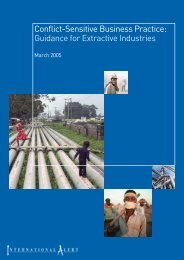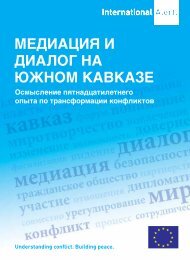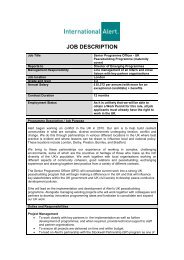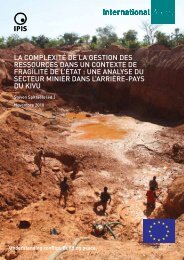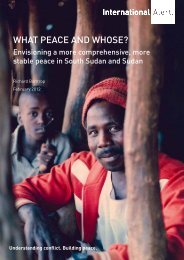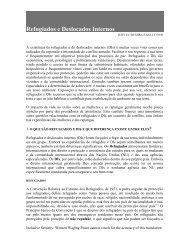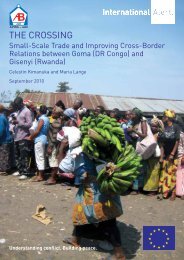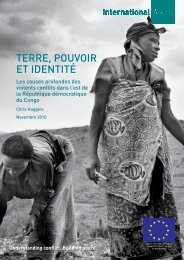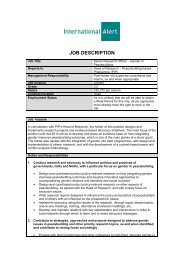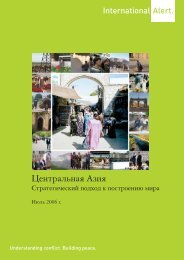The complexiTy of resource governance in a conTexT of sTaTe ... - Ipis
The complexiTy of resource governance in a conTexT of sTaTe ... - Ipis
The complexiTy of resource governance in a conTexT of sTaTe ... - Ipis
Create successful ePaper yourself
Turn your PDF publications into a flip-book with our unique Google optimized e-Paper software.
<strong>The</strong> complexity <strong>of</strong> <strong>resource</strong> <strong>governance</strong> <strong>in</strong> a context <strong>of</strong> state fragility: An analysis <strong>of</strong> the m<strong>in</strong><strong>in</strong>g sector <strong>in</strong> the Kivu h<strong>in</strong>terlands<br />
13<br />
Chapter 1: Northern Katanga<br />
(Steven Spittaels & Elisabeth Caesens)<br />
1.1 M<strong>in</strong>erals <strong>in</strong> Northern Katanga<br />
<strong>The</strong> <strong>in</strong>ternational m<strong>in</strong><strong>in</strong>g community has been <strong>in</strong>terested <strong>in</strong> the copper and cobalt reserves <strong>in</strong><br />
the south <strong>of</strong> the prov<strong>in</strong>ce <strong>of</strong> Katanga for decades. More recently, the north is rumoured to be as<br />
much <strong>of</strong> a “geological scandal” as the south, albeit for m<strong>in</strong>erals more closely related to those <strong>of</strong><br />
the Kivus, such as coltan, cassiterite and gold. <strong>The</strong> soil also conta<strong>in</strong>s high levels <strong>of</strong> other m<strong>in</strong>erals,<br />
such as silver. 2 <strong>The</strong> paragraphs below describe what is currently be<strong>in</strong>g extracted.<br />
Cassiterite<br />
Central Katangan territories, such as Manono, Malemba Nkulu and Mitwaba, have significant<br />
deposits <strong>of</strong> cassiterite (t<strong>in</strong> ore) and coltan, a byproduct. Manono hosted one <strong>of</strong> the few <strong>in</strong>dustrial<br />
companies operat<strong>in</strong>g north <strong>of</strong> the copper belt, the colonial t<strong>in</strong> company Géom<strong>in</strong>es, later renamed<br />
Zaire-Eta<strong>in</strong> (and Congo Eta<strong>in</strong> after the downfall <strong>of</strong> former President Mobutu). S<strong>in</strong>ce the Second<br />
Congo War (1998–2003), artisanal m<strong>in</strong>ers have taken over former <strong>in</strong>dustrial sites and begun<br />
exploit<strong>in</strong>g newly discovered deposits. 3 Official cassiterite production <strong>in</strong> 2009 from Manono,<br />
Malemba Nkulu and Mitwaba comb<strong>in</strong>ed amounted to approximately 1,368 tonnes. 4<br />
Coltan<br />
Coltan has always been the pr<strong>in</strong>cipal m<strong>in</strong>eral m<strong>in</strong>ed <strong>in</strong> Nyunzu and Kalemie territories, but it has<br />
also ga<strong>in</strong>ed <strong>in</strong> popularity <strong>in</strong> Manono and Malemba Nkulu. Coltan deposits attract more and more<br />
m<strong>in</strong>ers, 5 especially <strong>in</strong> the north <strong>of</strong> Manono. This heightened <strong>in</strong>terest might reflect the evolution <strong>of</strong><br />
the world market price, which has been better for coltan than cassiterite <strong>in</strong> the last two years (see the<br />
graphs <strong>of</strong> the evolution <strong>of</strong> world market prices 2008–10, and table <strong>of</strong> export prices <strong>in</strong> Annexe 2).<br />
An additional explanation for coltan’s popularity is a new prov<strong>in</strong>cial tax on Katangese m<strong>in</strong>erals<br />
travell<strong>in</strong>g through other prov<strong>in</strong>ces. While its impact on the coltan trade was limited, it has<br />
considerably disrupted the cassiterite trade. <strong>The</strong> prov<strong>in</strong>cial tax and its impact on the m<strong>in</strong>eral<br />
trade are discussed below.<br />
Table 1: Coltan production at the four most important coltan m<strong>in</strong>es <strong>in</strong> Tanganyika<br />
district (<strong>in</strong> kg)<br />
Jan Feb Mar Apr May Jun Jul Aug Sept Oct<br />
Kisengo 5,314 3,459 13,501 8,978 5,601 9,094 5,590 9,355 6,356 7,413 74,661<br />
Mayi<br />
Baridi<br />
1,750 690 2,250 1,700 4,050 3,250 5,674 19,364<br />
Malemba 1,246 650 3,094<br />
Katonge 2,500 1,700 4,450 2,950 7,541 1,500 3,300 23,941<br />
TOTAL 181,062<br />
Source: Division des m<strong>in</strong>es, Kalemie<br />
2 Interview, EITI representative, Lubumbashi, July 2010.<br />
3 Part <strong>of</strong> production at the Congo-Eta<strong>in</strong> sites has always been artisanal, even at the peak <strong>of</strong> <strong>in</strong>dustrialisation. <strong>The</strong> difference today is that<br />
the <strong>in</strong>dustrial component has entirely disappeared. New cassiterite m<strong>in</strong>er M<strong>in</strong><strong>in</strong>g M<strong>in</strong>eral Resources (MMR) claims it wants to revive the<br />
production cha<strong>in</strong> from extraction to transformation <strong>in</strong>to t<strong>in</strong> <strong>in</strong> Katanga prov<strong>in</strong>ce over the next few years.<br />
4 In comparison, Géom<strong>in</strong>es produced about seven times as much on a yearly basis dur<strong>in</strong>g World War II. Interview by IPIS, former Géom<strong>in</strong>es<br />
employee, Manono, June 2010.<br />
5 Interview, SAESSCAM staff, Lubumbashi, May 2010.





